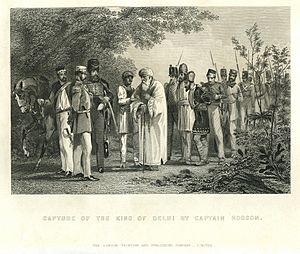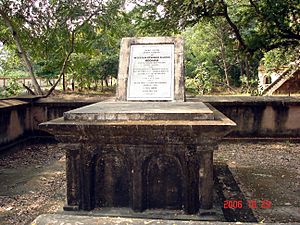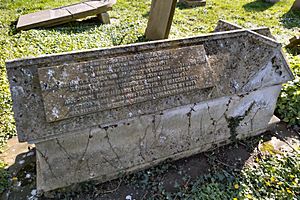William Stephen Raikes Hodson facts for kids
Quick facts for kids
William Stephen Raikes Hodson
|
|
|---|---|
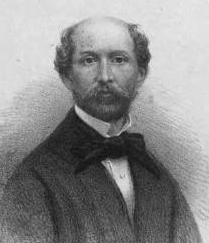
William Hodson, engraving printed as frontispiece to his biography Rider on a Grey Horse, by B. J. Cork (1958)
|
|
| Born | 19 March 1821 Maisemore Court, near Gloucester, England |
| Died | 11 March 1858 (aged 36) Lucknow, Oudh, British India |
| Buried |
La Martiniere College
|
| Allegiance | |
| Service/ |
Bengal Army |
| Rank | Brevet Major |
| Commands held | Corps of Guides Hodson's Horse |
| Battles/wars | First Anglo-Sikh War Indian Mutiny |
William Stephen Raikes Hodson (born March 19, 1821 – died March 11, 1858) was a British military leader. He commanded special cavalry units during the Indian Rebellion of 1857. This event is also known as the Indian Mutiny. Hodson became famous as "Hodson of Hodson's Horse", which was the name of his cavalry group.
One of his most well-known actions was capturing Bahadur Shah II. Bahadur Shah was the last Mughal ruler of Delhi. The next day, Hodson went to the rebel camp. He was greatly outnumbered but demanded the surrender of the Mughal princes. These princes were leading the rebellion near Delhi. Hodson later shot his prisoners, which caused much debate.
Many senior military leaders, like General Hugh Gough, praised Hodson's career. However, some people, including politicians, thought his actions were wrong. Despite this, top politicians, including the prime minister, still admired his work. Hodson is also known for helping to introduce the first khaki uniforms in the Indian army.
Contents
Early Life and Education
William Hodson was born on March 19, 1821, at Maisemore Court in England. His father, George Hodson, was a priest. William went to Rugby School and then to Trinity College, Cambridge. At 23, he joined the Indian Army.
He fought in the First Anglo-Sikh War and was injured. Hodson was known for being very direct. He often criticized military actions, which made him some enemies.
People described Hodson as a tall man with yellow hair and strong, watchful eyes. He was an excellent swordsman and a brilliant horseman. He could even sleep while riding his horse! Many said he was the best swordsman in the army.
Helping Form the Corps of Guides
In 1846, Hodson helped create the Corps of Guides. This was a special military unit. He worked with Lt Harry Burnett Lumsden. One of Hodson's jobs was to choose uniforms for the new regiment. He and Lumsden decided on a lightweight uniform. It was a khaki or "drab" color. This color would help the soldiers blend in with the dusty land.
In 1848, Hodson asked his brother in England to send "drab" cloth for 900 men. He also asked for 300 carbines (a type of rifle). Because of this, Hodson and Lumsden were the first officers to dress a regiment in khaki. This is seen as an early step towards modern camouflage uniforms.
Later, in 1849, Hodson worked as an Assistant Commissioner in Amritsar. He traveled in Kashmir and Tibet. In 1852, he became the leader of the Corps of Guides.
Family and Hobbies
On January 5, 1852, William married Susan Annette in Calcutta. They had a daughter, Olivia, in 1853, but she sadly died in 1854.
It was unusual for a British soldier in India to have a Cambridge degree. William also loved reading classical books. He was very good at languages. He learned Hindustani and Persian. His mentor, Sir Henry Lawrence, encouraged him. Hodson found learning languages relaxing. He even enjoyed reading Xenophon (an ancient Greek writer) without translation.
Role in the Indian Rebellion
When the Indian Mutiny began, Hodson became well-known. He rode long distances with important messages. He traveled 152 miles in 72 hours through dangerous areas. After this brave act, he was allowed to create a new cavalry regiment. This group of 2,000 irregular cavalrymen became "Hodson's Horse". He also led the Intelligence Department.
Hodson played a big part in the Siege of Delhi. His most important success was capturing the Mughal emperor, Bahadur Shah II. However, he also faced criticism for executing three Mughal princes. These were Bahadur's sons Mirza Mughal and Mirza Khizr Sultan, and his grandson Mirza Abu Bakr.
Capturing the Emperor
The British knew that the old king of Delhi was a symbol for the rebels. The king and his sons were camped outside Delhi. Hodson volunteered to go with 50 of his horsemen. He got permission to ride to the enemy camp.
Hodson rode six miles into the camp. It held about 6,000 armed rebels. It is said they put down their weapons when he ordered them to. Hodson accepted Bahadur Shah II's surrender. He promised the emperor that his life would be spared. This capture was a big blow to the rebels. As a sign of surrender, the emperor gave Hodson two valuable swords. One had the name "Nadir Shah" and the other the seal of Jahangir. Hodson intended to give these to Queen Victoria. The Jahangir sword is still in the Royal Collection.
The Princes' Execution
The king's sons had refused to surrender at first. The next day, Hodson went back with a few horsemen. He demanded the princes' surrender without any conditions. Again, thousands of rebels gathered. Hodson ordered them to disarm, and they did. He sent the princes away with an escort of ten men. With his remaining ninety men, he collected the rebels' weapons.
The princes were taken towards Delhi in a bullock-cart. As they neared the city gate, a crowd gathered. Hodson ordered the three princes off the cart. He then took a carbine from a soldier and shot them. He took their rings, armbands, and jeweled swords. Their bodies were left for all to see in front of a police station. The gate where they were killed is still called the Khooni Darwaza, or "Bloody Gate."
These actions were very controversial, even at the time. Frederick Roberts, 1st Earl Roberts, a junior officer then, later called it a "blot." Bahadur Shah II was put on trial. But because Hodson had promised to spare his life, he was sent away to Rangoon, Burma. He died there in 1862 at age 87.
Financial Challenges
Throughout his career, Hodson faced questions about money. He was investigated several times, but nothing was ever proven. Some people said he took things unfairly. Others said these accusations came from those who disliked him.
His brother, Rev. G. Hodson, said that William's belongings after his death showed no signs of stolen goods. Sir Charles Gough, who checked his possessions, agreed. However, Sir Henry Norman stated that Hodson sent thousands of pounds to Calcutta that could only have come from taking things during battles.
Despite these claims, Hodson died without much money. His belongings, including a ring, watch, and Bible, sold for only £170. His widow did not have enough money to travel home. She received help from a special fund. Queen Victoria even offered her a place to live at Hampton Court Palace.
Death
On March 11, 1858, Hodson's regiment was in Lucknow. During an attack on the Begum's palace (Begum Kothi), he was shot. His last words were, "I hope I have done my duty."
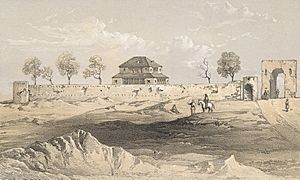
On the evening of March 12, 1858, he was buried in the garden of La Martiniere Lucknow. His grave is still there today. The memorial says, "Here lies all that could die of William Stephen Raikes Hodson."
Legacy and Recognition
In 1859, the Prime Minister Earl of Derby and the Secretary of State for India Lord Stanley praised Hodson in parliament. Lord Stanley said Hodson had a "short but brilliant military career." He noted Hodson's courage and skill. He also mentioned how Hodson could switch between different duties with great energy. He said Hodson "crowded into the brief space of twelve eventful years the services and adventures of a long life."
The prime minister called Hodson "a model of chiefs of irregular forces." He admired Hodson's bravery and how he cared for his men. This made his troops fight like British soldiers. He said, "He has met a soldier's death. It will be long before the people lose the memory of Hodson."
General Hugh Gough also praised him. He called Hodson "a finer or more gallant soldier never breathed." He added that Hodson was "perfection" as a cavalry soldier.
Because of his service, Hodson's widow received a special pension. Queen Victoria also honored him in 1860. She gave his widow a special apartment at Hampton Court Palace.
A large monument to Major Hodson was built in Lichfield Cathedral. It was carved by Thomas Earp. Hodson also appears as a main character in the novel Follow the Drum (1972) by James Leasor.
See also
- Chhibramau for Hodson's Adventure


